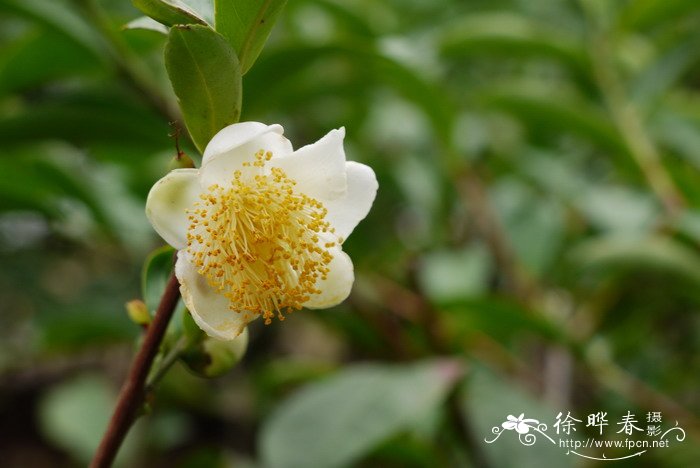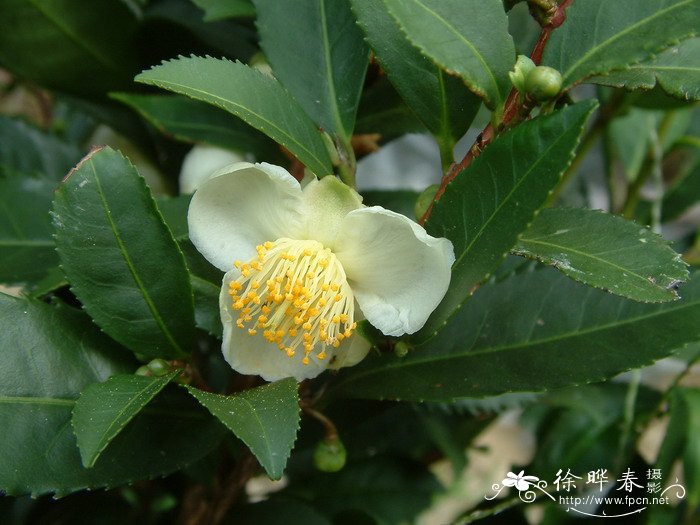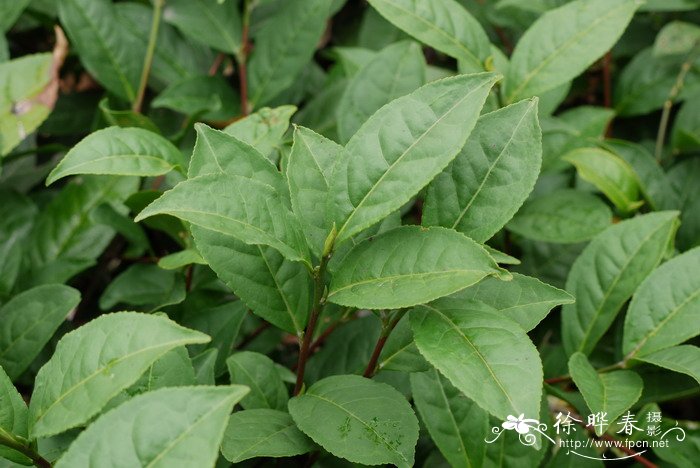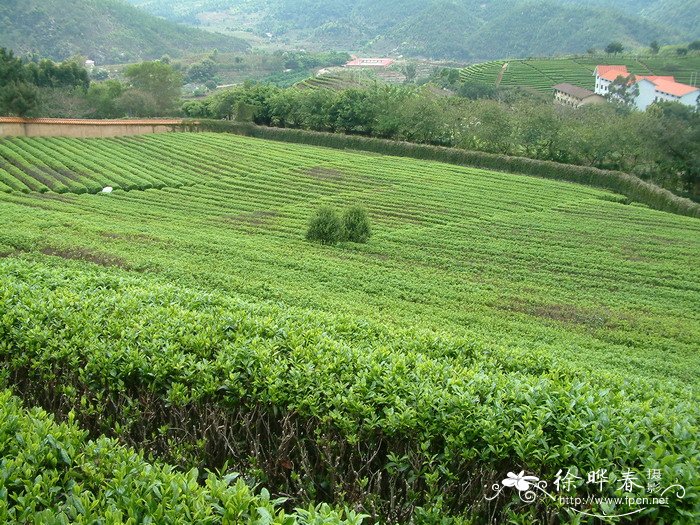茶Camellia sinensis
中文名(Chinese Name):茶
学名(Scientific Name):Camellia sinensis (L.) Kuntze
英文名(English Common Name):tea
别名(Chinese Common Name):
异名(Synonym):Camellia Sect. Thea (Linn.) Dyer Camellia waldenae S. Y. Hu Camellia sinensis f. parvifolia (Miq.) Sealy Camellia sinensis var. waldenae (S. Y. Hu) H. T. Chang Camellia longlingensis F. C. Zhang, G. B. Chen et M. D. Tang Camellia cantonensis Lour. Camellia oleosa (Lour.) Wu Thea bohea L. Thea cochinchinensis Lour. Thea cantonensis Lour. Thea oleosa Lour. Thea viridis L. Thea chinensis Sims Thea grandifolia Salisb. Thea sinensis L. Camellia sinensis f. macrophylla (Sieber) Kitam. Camellia sinensis f. formosensis Kitam. Theaphylla cantonensis (Lour.) Raf. Thea sinensis var. macrophylla Siebold Camellia thea Link Camellia bohea (L.) Sweet Camellia chinensis (Sims) Kuntze Camellia sinensis f. rosea (Makino) Kitam. Camellia theifera var. macrophylla (Siebold ex Miq.) Matsum. Camellia viridis Link Theaphylla anamensis Raf. Theaphylla laxa Raf. Theaphylla oleifera Raf. Theaphylla viridis Raf. Thea latifolia Lodd. ex Sweet Thea longifolia Nois. ex Steud. Thea sasangua Nois. ex Cels Thea stricta Hayne
科属(Family & Genus):山茶科(Theaceae)山茶属
形态特征(Description):灌木或小乔木,嫩枝无毛。叶革质,长圆形或椭圆形,长4-12厘米,宽2-5厘米,先端钝或尖锐,基部楔形,上面发亮,下面无毛或初时有柔毛,侧脉5-7对,边缘有锯齿,叶柄长3-8毫米,无毛。花1-3朵腋生,白色,花柄长4-6毫米,有时稍长;苞片2片,早落;萼片5片,阔卵形至圆形,长3-4毫米,无毛,宿存;花瓣5-6片,阔卵形,长1-1.6厘米,基部略连合,背面无毛,有时有短柔毛;雄蕊长8-13毫米,基部连生1-2毫米;子房密生白毛;花柱无毛,先端3裂,裂片长2-4毫米。蒴果3球形或1-2球形,高1.1-1.5厘米,每球有种子1-2粒。花期10月至翌年2月。
分布(Distribution):野生种遍见于长江以南各省的山区,广为栽培。
用途(Use):
引自中国植物志英文版:FOC Vol. 12 Page 373, 376, 377
Camellia sinensis (Linnaeus) Kuntze, Trudy Imp. S.-Peterburgsk. Bot. Sada. 10: 195. 1887.
茶 cha| Theaceae | Camellia
Shrubs or trees, 1-5(-9) m tall. Young branches grayish yellow, glabrous; current year branchlets purplish red, white pubescent; terminal buds silvery gray sericeous. Petiole 4-7 mm, pubescent, glabrescent; leaf blade elliptic, oblong-elliptic, or oblong, 5-14 × 2-7.5 cm, leathery, abaxially pale green and glabrous or pubescent, adaxially dark green, shiny, and glabrous, midvein ± raised on both surfaces, secondary veins 7-9 on each side of midvein and ± raised on both surfaces, reticulate veins visible on both surfaces, base cuneate to broadly cuneate, margin serrate to serrulate, apex bluntly acute to acuminate and with an obtuse tip. Flowers axillary, solitary or to 3 in a cluster, 2.5-3.5 cm in diam. Pedicel 5-10 mm, recurved, pubescent or glabrous, thickened toward apex; bracteoles 2, caducous, ovate, ca. 2 mm. Sepals 5, persistent, broadly ovate to suborbicular, 3-5 mm, outside glabrous or white pubescent, inside white sericeous, margin ciliolate. Petals 6-8, white; outer 1-3 petals sepaloid; inner petals obovate to broadly obovate, 1.5-2 × 1.2-2 cm, basally connate, apex rounded. Stamens numerous, 0.8-1.3 cm, glabrous; outer filament whorl basally connate for ca. 2 mm. Ovary globose, densely white pubescent, tomentose, or subglabrous, 3-loculed; style ca. 1 cm, glabrous or base pubescent, apically 3-lobed. Capsule oblate, 2-coccal, or rarely globose, 1-1.5 × 1.5-3 cm, 1- or 2-loculed with 1 seed per locule; pericarp ca. l mm thick. Seeds brown subglobose, 1-1.4 cm in diam. Fl. Oct-Feb, fr. Aug-Oct.
Evergreen broad-leaved forests, thickets; 100-2200 m. Anhui, Fujian, Guangdong, Guangxi, Guizhou, Hainan, Henan, Hubei, Hunan, Jiangsu, Jiangxi, S Shaanxi, Sichuan, Taiwan, SE Xizang, Yunnan, Zhejiang [NE India, S Japan, S Korea, Laos, Myanmar, Thailand, Vietnam].
Tea is made from the vegetative buds and young leaves of Camellia sinensis var. sinensis and C. sinensis var. assamica. There is a long history of the use and cultivation of tea in China. Tea is usually distinguished by the Chinese people as small leaf tea (var. sinensis) with a more northern distribution and large leaf tea (var. assamica) with a more southern distribution. However, the other varieties of C. sinensis and even some other species of Camellia are locally used as tea. The distinction between green tea and black tea concerns the processing of the leaves whether they are just wilted before drying (green tea) or wilted and then fermented before drying (black tea).
Because of extensive cultivation, it is often difficult to know for certain whether specific collections of var. sinensis and var. assamica are wild, cultivated, or escaped. For this reason, the actual wild distribution of these two varieties is uncertain.




(责任编辑:徐晔春)
学名(Scientific Name):Camellia sinensis (L.) Kuntze
英文名(English Common Name):tea
别名(Chinese Common Name):
异名(Synonym):Camellia Sect. Thea (Linn.) Dyer Camellia waldenae S. Y. Hu Camellia sinensis f. parvifolia (Miq.) Sealy Camellia sinensis var. waldenae (S. Y. Hu) H. T. Chang Camellia longlingensis F. C. Zhang, G. B. Chen et M. D. Tang Camellia cantonensis Lour. Camellia oleosa (Lour.) Wu Thea bohea L. Thea cochinchinensis Lour. Thea cantonensis Lour. Thea oleosa Lour. Thea viridis L. Thea chinensis Sims Thea grandifolia Salisb. Thea sinensis L. Camellia sinensis f. macrophylla (Sieber) Kitam. Camellia sinensis f. formosensis Kitam. Theaphylla cantonensis (Lour.) Raf. Thea sinensis var. macrophylla Siebold Camellia thea Link Camellia bohea (L.) Sweet Camellia chinensis (Sims) Kuntze Camellia sinensis f. rosea (Makino) Kitam. Camellia theifera var. macrophylla (Siebold ex Miq.) Matsum. Camellia viridis Link Theaphylla anamensis Raf. Theaphylla laxa Raf. Theaphylla oleifera Raf. Theaphylla viridis Raf. Thea latifolia Lodd. ex Sweet Thea longifolia Nois. ex Steud. Thea sasangua Nois. ex Cels Thea stricta Hayne
科属(Family & Genus):山茶科(Theaceae)山茶属
形态特征(Description):灌木或小乔木,嫩枝无毛。叶革质,长圆形或椭圆形,长4-12厘米,宽2-5厘米,先端钝或尖锐,基部楔形,上面发亮,下面无毛或初时有柔毛,侧脉5-7对,边缘有锯齿,叶柄长3-8毫米,无毛。花1-3朵腋生,白色,花柄长4-6毫米,有时稍长;苞片2片,早落;萼片5片,阔卵形至圆形,长3-4毫米,无毛,宿存;花瓣5-6片,阔卵形,长1-1.6厘米,基部略连合,背面无毛,有时有短柔毛;雄蕊长8-13毫米,基部连生1-2毫米;子房密生白毛;花柱无毛,先端3裂,裂片长2-4毫米。蒴果3球形或1-2球形,高1.1-1.5厘米,每球有种子1-2粒。花期10月至翌年2月。
分布(Distribution):野生种遍见于长江以南各省的山区,广为栽培。
用途(Use):
引自中国植物志英文版:FOC Vol. 12 Page 373, 376, 377
Camellia sinensis (Linnaeus) Kuntze, Trudy Imp. S.-Peterburgsk. Bot. Sada. 10: 195. 1887.
茶 cha| Theaceae | Camellia
Shrubs or trees, 1-5(-9) m tall. Young branches grayish yellow, glabrous; current year branchlets purplish red, white pubescent; terminal buds silvery gray sericeous. Petiole 4-7 mm, pubescent, glabrescent; leaf blade elliptic, oblong-elliptic, or oblong, 5-14 × 2-7.5 cm, leathery, abaxially pale green and glabrous or pubescent, adaxially dark green, shiny, and glabrous, midvein ± raised on both surfaces, secondary veins 7-9 on each side of midvein and ± raised on both surfaces, reticulate veins visible on both surfaces, base cuneate to broadly cuneate, margin serrate to serrulate, apex bluntly acute to acuminate and with an obtuse tip. Flowers axillary, solitary or to 3 in a cluster, 2.5-3.5 cm in diam. Pedicel 5-10 mm, recurved, pubescent or glabrous, thickened toward apex; bracteoles 2, caducous, ovate, ca. 2 mm. Sepals 5, persistent, broadly ovate to suborbicular, 3-5 mm, outside glabrous or white pubescent, inside white sericeous, margin ciliolate. Petals 6-8, white; outer 1-3 petals sepaloid; inner petals obovate to broadly obovate, 1.5-2 × 1.2-2 cm, basally connate, apex rounded. Stamens numerous, 0.8-1.3 cm, glabrous; outer filament whorl basally connate for ca. 2 mm. Ovary globose, densely white pubescent, tomentose, or subglabrous, 3-loculed; style ca. 1 cm, glabrous or base pubescent, apically 3-lobed. Capsule oblate, 2-coccal, or rarely globose, 1-1.5 × 1.5-3 cm, 1- or 2-loculed with 1 seed per locule; pericarp ca. l mm thick. Seeds brown subglobose, 1-1.4 cm in diam. Fl. Oct-Feb, fr. Aug-Oct.
Evergreen broad-leaved forests, thickets; 100-2200 m. Anhui, Fujian, Guangdong, Guangxi, Guizhou, Hainan, Henan, Hubei, Hunan, Jiangsu, Jiangxi, S Shaanxi, Sichuan, Taiwan, SE Xizang, Yunnan, Zhejiang [NE India, S Japan, S Korea, Laos, Myanmar, Thailand, Vietnam].
Tea is made from the vegetative buds and young leaves of Camellia sinensis var. sinensis and C. sinensis var. assamica. There is a long history of the use and cultivation of tea in China. Tea is usually distinguished by the Chinese people as small leaf tea (var. sinensis) with a more northern distribution and large leaf tea (var. assamica) with a more southern distribution. However, the other varieties of C. sinensis and even some other species of Camellia are locally used as tea. The distinction between green tea and black tea concerns the processing of the leaves whether they are just wilted before drying (green tea) or wilted and then fermented before drying (black tea).
Because of extensive cultivation, it is often difficult to know for certain whether specific collections of var. sinensis and var. assamica are wild, cultivated, or escaped. For this reason, the actual wild distribution of these two varieties is uncertain.
(责任编辑:徐晔春)
踩一下[0]

顶一下[2]